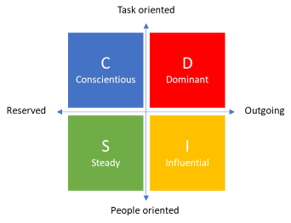 If you are new to the idea of Team Praxis, please read our introduction to the concept before using the table below to improve your communications with team members, stakeholders and anyone else involved in your project, programme or portfolio.
If you are new to the idea of Team Praxis, please read our introduction to the concept before using the table below to improve your communications with team members, stakeholders and anyone else involved in your project, programme or portfolio.
When implementing project and programme processes, the different character types would focus on different aspects:
 Concientious behaviour would typically propose or want to see: Concientious behaviour would typically propose or want to see:
-
processes designed which are logical, rigorous and well defined; -
processes that are updated as changes become necessary; -
full compliance by all those involved in the adoption and use of processes; -
processes which are independently reviewed and assured as to their application; -
decisions made as part of the processes which are objective and based on comprehensive and accurate information; - decisions challenged and defended especially if they are not thought through or evidenced.
Someone exhibiting concientious behaviour would typically be perceived as: -
formal and someone who always sticks to the agreed processes; -
a perfectionist who may research or iterate to remove uncertainty; -
persistent in the way they work through processes; -
seeking facts and data as part of the decisions they make; -
wishing to design the processes as they like to see order and will make them logical and robust; -
diplomatic in the way they resolve conflict; -
tending to work in isolation on processes such as planning and the management of risk. |  Dominant behaviour would typically propose or want to see: Dominant behaviour would typically propose or want to see:
-
centralised decision making regarding the design of processes to ensure they are simple and focused on supporting delivery; -
clear communication regarding the requirement to comply with processes; -
flexibility in the way processes are applied to suit the situation; -
will be happy making decisions often when information is not complete or there is uncertainty; - strong leadership to drive the process and make the necessary decisions.
Someone exhibiting dominant behaviour would typically be perceived as: -
formal and working broadly to the process where it does not constrain delivery; -
thinking and acting independently and therefore not always following processes to the letter; -
decisive as they reach decision points within the process flow; -
action-orientated and frustrated when processes slow delivery; -
a problem solver who is keen to quickly resolve issues and have others do the same; -
controlling and dominant in terms of the way processes are applied and decisions are made. |
 Steady behaviour would typically propose or want to see: Steady behaviour would typically propose or want to see:
-
the people who will use them involved in the formulation, writing and practice; -
adequate time allowed for decisions to be discussed with those impacted by the processes; -
decisions made based on both subjective as well as objective data; -
full and ready adoption and application of the agreed processes; -
adequate support provided to people to allow them to develop the necessary capability; - commitment to planning as it is the foundation for the effective operation of all processes.
Someone exhibiting steady behaviour would typically be perceived as: -
informal in their attitude to people but still working to the agreed process; -
cautious as they work through agreed processes and wishing to minimise risk; -
supportive of others and willing to commit time and energy; -
patient and considerate of others as they work through processes; -
slow to act especially when there is uncertainty as to the steps in the process or decisions that need to be made; -
aiming to avoid conflict wherever possible during the application of processes. |  Influential behaviour would typically propose or want to see: Influential behaviour would typically propose or want to see:
-
communication and discussion amongst the team of the value of applying the processes; -
processes that are flexible, can be adapted to suit the context and applied appropriately; -
alternative perspectives and voices considered as part of the process flow; -
processes which encourage collaboration through group discussions and collective working; - innovative processes being identified and tested.
Someone exhibiting influential behaviour would typically be perceived as: -
a champion for new processes and engaging others in their application; -
good at getting team members input to processes; -
informal and often working around the process where seen as constraining; -
a risk taker when taking decisions and applying processes; -
optimistic and spontaneous; -
fast paced in terms of the adoption and application of processes; -
innovative in the application of processes; -
making decisions based on gut feel and later backing up with data. |
Thanks to Donnie MacNicol of Team Animation for providing this page.
 If you are new to the idea of Team Praxis, please read our introduction to the concept before using the table below to improve your communications with team members, stakeholders and anyone else involved in your project, programme or portfolio.
If you are new to the idea of Team Praxis, please read our introduction to the concept before using the table below to improve your communications with team members, stakeholders and anyone else involved in your project, programme or portfolio.
 Concientious behaviour would typically propose or want to see:
Concientious behaviour would typically propose or want to see: Dominant behaviour would typically propose or want to see:
Dominant behaviour would typically propose or want to see: Steady behaviour would typically propose or want to see:
Steady behaviour would typically propose or want to see: Influential behaviour would typically propose or want to see:
Influential behaviour would typically propose or want to see:



